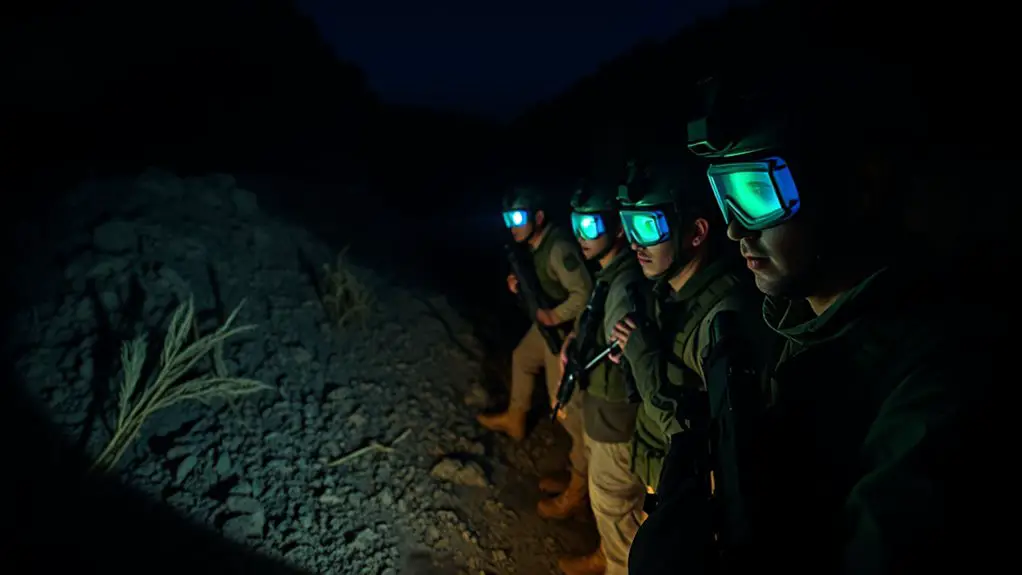To develop night vision awareness in training, start by practicing dark adaptation and using ambient light. Focus on distant lights to sharpen your focus and enhance contrast sensitivity by observing shadows. Incorporate exercises like shadow walking and nighttime obstacle courses to build confidence and awareness. Using night vision equipment like goggles or adjustable flashlights can also help. With the right techniques and tools, you'll enhance your ability to navigate in low-light conditions, and there's much more to explore.
Understanding Night Vision Mechanics
Night vision is a fascinating blend of biology and physics that allows you to see in low-light conditions. Your eyes contain specialized cells called rods, which are sensitive to dim light. These rods enable you to detect shapes and movements even when the sun sets. When you step into darkness, your eyes undergo a process called dark adaptation. This process gradually increases your sensitivity to light, allowing you to navigate through the night without artificial sources.
In addition, understanding how colors fade in low light can enhance your awareness. Reds and greens might seem less vibrant, while contrasts become more pronounced. The ability to recognize shapes and outlines is essential for freedom in low-light environments. By honing your night vision mechanics, you empower yourself to move confidently and safely, whether you're exploring nature or engaging in outdoor activities. Embrace the night; there's a world waiting for you just beyond the shadows.
Importance of Adaptation to Darkness
As you shift from a well-lit area into darkness, adapting to low light is essential for maintaining your safety and awareness. This adaptation isn't just about seeing; it's about thriving in the night. When you embrace darkness, you empower yourself to traverse the unseen and discover your surroundings.
Here are some key reasons why adapting to darkness matters:
- Increased Awareness: Your senses sharpen, making you more attuned to subtle sounds and movements.
- Enhanced Safety: You'll identify potential hazards before they become threats.
- Freedom of Movement: Traveling without being hindered by light restrictions allows for greater exploration.
- Improved Confidence: The more comfortable you are in the dark, the more fearless you'll feel in unfamiliar environments.
Techniques to Enhance Night Vision
Once you've adapted to darkness, enhancing your night vision becomes the next step in maximizing your awareness. Start by practicing eye exercises, like focusing on distant lights, which helps strengthen your vision in low-light conditions. Utilize ambient light sources, such as the moon or stars, to train your eyes to pick up subtle changes in the environment.
You can also develop contrast sensitivity by observing the interplay of shadows and shapes in the dark. Avoid staring directly at bright lights; instead, let your peripheral vision guide you. This allows your rods—responsible for low-light vision—to do their work without being overwhelmed.
Lastly, consider your diet. Foods rich in vitamins A and C can support your vision. By combining these techniques, you'll sharpen your night awareness, allowing you to navigate the dark with greater freedom and confidence.
Training Exercises for Night Awareness
Many people find that engaging in specific training exercises can markedly enhance their night awareness. Embracing the darkness can be liberating, and these exercises will help you navigate it with confidence. Here are four effective drills to boost your night vision skills:
Engaging in targeted exercises can significantly improve your night awareness and confidence in navigating the darkness.
- Shadow walking: Move silently through a dark area, focusing on sounds and subtle movements around you.
- Nighttime obstacle course: Set up a course using natural terrain; practice maneuvering through it without artificial light.
- Visual memory drills: Spend time in the dark, then recall and sketch what you remember about your surroundings.
- Stargazing: Observe constellations and celestial objects; this sharpens your ability to detect faint lights against a dark background.
Incorporating these exercises into your routine will allow you to develop a deeper connection with your environment, ultimately enhancing your freedom to explore the night.
Utilizing Tools and Equipment
While training exercises are essential for enhancing your night awareness, incorporating the right tools and equipment can further elevate your experience. Consider using night vision goggles or binoculars, which allow you to see clearly in low-light conditions. These tools can help you identify potential obstacles and navigate with ease.
Additionally, a reliable flashlight with adjustable brightness gives you control over your visibility without compromising your night adaptation. You might also want to invest in reflective gear to enhance your presence without drawing attention.
A good map and compass can help you maintain spatial awareness, especially in unfamiliar terrains. Remember, the goal is to blend technology with your natural instincts, enhancing your freedom to explore the night. Equip yourself properly, and you'll find that your confidence grows alongside your night vision awareness, empowering you to venture boldly into the darkness.
Real-World Application Scenarios
As you develop your night vision awareness, applying your skills in real-world scenarios can greatly enhance your confidence and effectiveness. When the sun sets, the world transforms, and so should your approach. Here are some scenarios where you can put your training to the test:
Developing night vision awareness is key to navigating the transformed world after sunset; practical scenarios can boost your confidence and effectiveness.
- Navigating in the wilderness: Practice moving through natural settings, relying on your night vision to identify paths and obstacles.
- Urban exploration: Explore city streets after dark, focusing on identifying movement and potential threats.
- Survival training: Simulate emergency situations where you must rely on your instincts and night vision to find resources or navigate to safety.
- Self-defense drills: Conduct drills in low-light conditions to sharpen your response time and awareness of surroundings.
Frequently Asked Questions
Can Diet Influence My Night Vision Capabilities?
Yes, your diet can influence night vision. Nutrients like vitamin A and antioxidants help maintain healthy eyes. Incorporating foods rich in these nutrients could enhance your ability to see in low-light conditions. Don't overlook your nutrition!
How Long Does It Take to Adapt to Darkness?
It usually takes about 20 to 30 minutes for your eyes to fully adapt to darkness. During this time, you'll notice your vision improving as your pupils widen and light-sensitive cells activate.
Are There Specific Age-Related Changes in Night Vision?
As time dances on, your night vision can wane; age brings changes like fading stars. You may notice slower adaptation and less clarity in dim light, but don't worry—practicing can help rekindle your sight's fire.
Can Certain Medications Affect Night Vision?
Yes, certain medications can indeed affect your night vision. Things like antihistamines, antidepressants, and blood pressure meds might cause blurred vision or sensitivity to light, making it harder for you to see in low-light conditions.
Is Night Vision Training Applicable for All Activities?
Imagine traversing a moonlit forest; night vision training enhances your ability to see. It's not just for specific tasks—it's applicable across activities, giving you the freedom to explore and thrive in the darkness.




